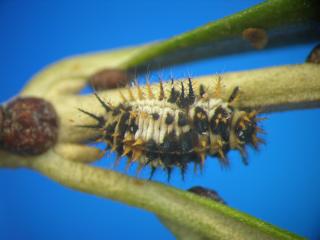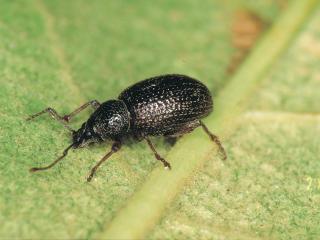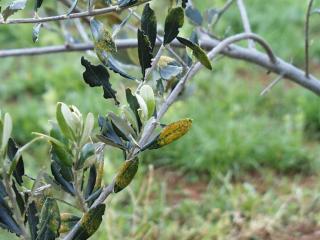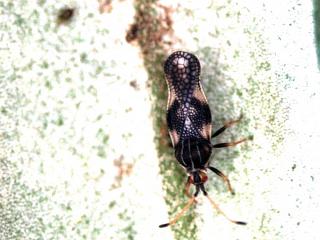Pests
Black scale
Severe infestations of black scale (Saissetia oleae) will stunt growth, cause early leaf-drop, branch die back and a lack of fruit.
The scales produce honeydew on which sooty mould grows. This black powdery coating interferes with photosynthesis, reduces tree vigour and yield and can taint the oil. The mould must be washed off fruit before processing.
Adult female black scales are 1.9–5mm long, 1–4mm wide and 1.2–2.5mm high. They are dark brown with an H-shaped ridge on the back. The surface becomes smoother and almost black as they start producing eggs. When the scale cover is removed hundreds of eggs may be seen, looking like grains of sand.
The eggs hatch into tiny young, known as crawlers, which are pale pinkish-orange. They are most abundant in summer, first appearing in early to mid-December, with a second generation in early autumn. Spray with a horticultural oil which is most effective if aimed at the crawler stage. Using a x10 hand lens to check whether eggs have hatched under the scale cover helps define the time to spray. Most eggs hatch over a four to six week period, so more than one spray may be required.
Controlling ants, which spread the infestations throughout the trees, will help reduce the incidence of scale.
Parlatoria scale
Parlatoria scales (Parlatoria oleae) are circular and pale brownish grey with a black spot in the middle. They are smaller than black scales and are considered a less serious pest on olive trees.
Apple weevil
Mainly a pest in the south-west, apple weevils (Otiorhynchus cribricollis) attack shoots and foliage, compromising the vigour of the tree. The flightless adults feed at night; by day they are inactive and hide under bark, in the crotches of branches and between fruit and leaves, or burrow into the soil at the base of the tree. Adult apple weevils are about 8mm long, uniform brown and slightly bulbous at the abdomen.
Larvae develop in the soil, from where the adults emerge during November and December. Because adults are “hairy”, Dacron crafter’s batting wrapped around the tree trunk will trap and desiccate many of them. If the batting is sprayed with repellent chemicals the kill rate may be enhanced. Insecticides may also be used and should be applied to the base of the trunk and the crotches of branches, instead of the canopy where they could kill beneficial insects. Apple weevils breed on weeds like capeweed, so weed removal helps reduce their abundance.
Garden weevil
Considered a less important pest on olive trees, the garden weevil’s (Phlyctinus callosus) habits are similar to those of apple weevil. Adult garden weevils are about 7mm long and greyish brown with a pale but prominent V-shaped stripe on the lower part of the bulbous abdomen.
Batting does not work as well against this weevil and sticky material applied on a substrate like a plastic band (to avoid ringbarking trees) may provide protection.
Rutherglen bug
Adult rutherglen bugs (Nysius vinitor) are narrow bodied, about 3–4mm long and greyish brown with dark markings. The nymphs are dark red and swollen. The adults survive winter and breed in early spring. Large numbers do not usually develop until early summer. Reducing summer and autumn weeds, where the bug's breed, may assist control.
The damage that rutherglen bugs cause when feeding on olive trees includes twig death and the development of a scorched appearance on the leaves. Young trees are most susceptible. Over small areas, canopy spraying with repellent materials during invasive flight periods may help protect trees.
Olive lace bug
Olive lace bugs (Froggattia olivinia) are about 3mm long (including the wings) and mottled dark brown and cream, with black-tipped antennae. They pierce the leaves with their mouthparts. Although most of this activity takes place on the undersides of the leaves, the most common indications are on the upper surface which becomes stippled with greenish to yellow-brown dots. With heavy infestations the yellowing effect may dominate, leading to desiccation and leaf-drop, in turn reducing the vigour and yield of the tree.
Eggs are inserted into the tissue on the undersides of the leaves where they over-winter. In spring monitor the leaves for the emerging nymphs which may vary in colour from cream to greenish yellow to pinkish orange. The final nymphal stage is green to dark grey and spiny.
Olive lace bugs are relatively sedentary. Regularly pruning and destroying infested foliage helps protect small trees. If relying on insecticide, direct the spray at the undersides of leaves. More than one application may be required to achieve control of insects emerging from eggs laid within plant tissue.




